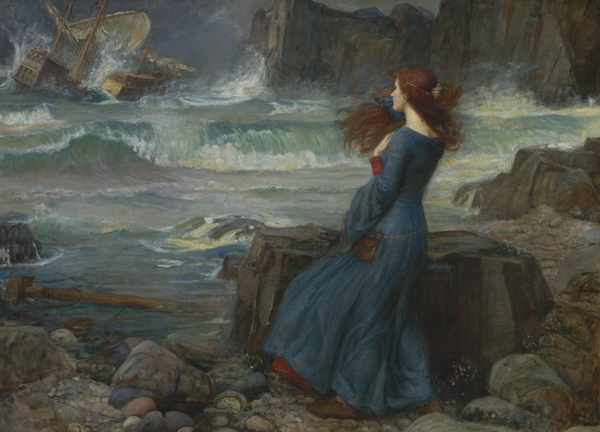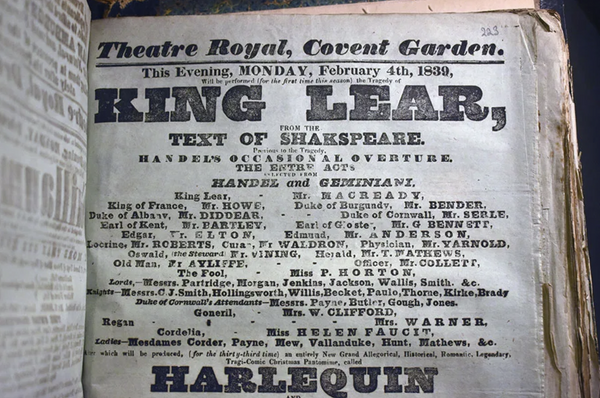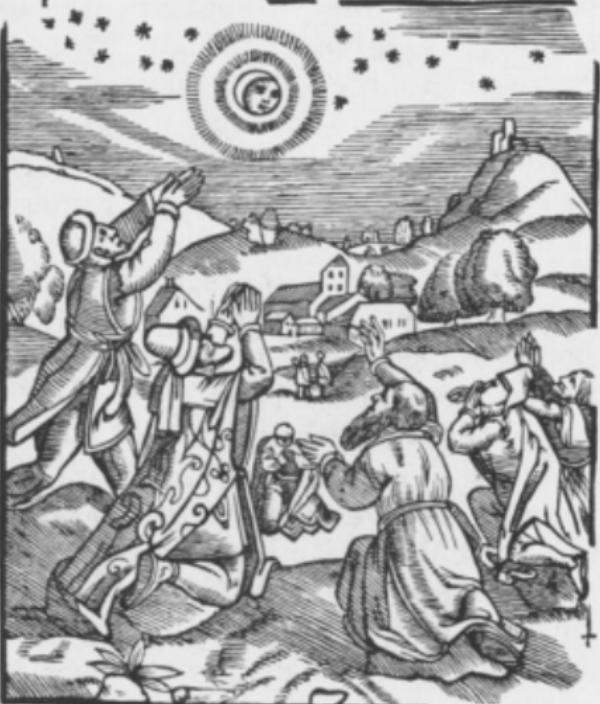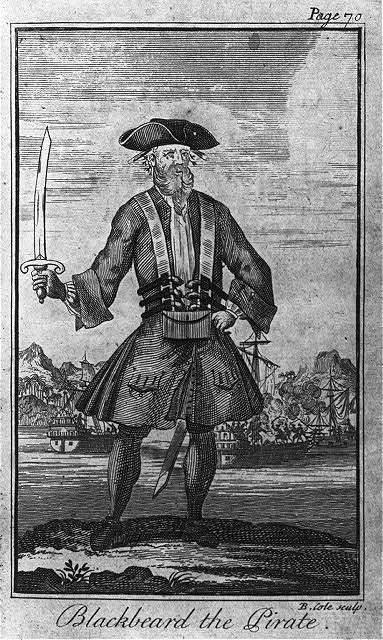The Hatch and Brood of Time Volume 5: October 25, 2020 By London Johns
“What are these,/So withered, and so wild in their attire,/That look not like th’ inhabitants o’ th’ Earth/And yet are on ’t? . . . You should be women,/And yet your beards forbid me to interpret/That you are so.” (Macbeth 17) This is how Banquo introduced the three Weird Sisters in Shakespeare’s Macbeth. The Witches were disturbing, otherworldly, and wild figures, but apart from their strangeness, Shakespeare did not describe their physical appearances in detail. However, they had one particularly curious feature: their beards. The Witches, who in every other way looked like women, had beards. In Early Modern England, beards on men indicated power and status, but beards on women were deemed unusual and disturbing. In literature, women’s beards were still sometimes seen as signs of power, and bearded women powerful figures; however, their power was supernatural rather than economic or political, and for the most part existed only in fiction.
In order to examine the cultural place of women’s beards, it is necessary to first describe the place of men’s beards. Will Fisher’s “The Renaissance Beard: Masculinity in Early Modern England” pointed out the prevalence of bearded men in Elizabethan and Jacobean portraits: out of sixty portraits in an exhibition, fifty-five included some kind of facial hair. The frequency with which they appeared suggested that beards were fashionable, at least among the elite. This trend was reflected in literature; according to Fisher, all but four of Shakespeare’s plays explicitly mentioned beards. The others, “Richard III, Henry IV, Titus Andronicus, and Pericles,” may have required bearded actors or prosthetic beards (Fisher 159). Several books were written specifically on the significance of beards. According to Thomas Hall’s The Loathsomeness of Long Hair, “A decent growth of the Beard is a signe of Manhood, and given by God to distinguish the Male from the Female sex, this is a badge of Virility, [long hair] of Vanity” (Hall 48). According to Hall, the beard was not only a symbol of status, but a sign of masculinity granted by God. John Valerian’s 1533 work on beards claimed that beards set the “vigorous strength” of men apart from the “tenderness of women” (qtd. in Fisher 167). It is fitting, therefore, that young, beardless theater apprentices were tasked with playing women onstage -- a role that they may have resented, as Flute in A Midsummer Night’s Dream insisted that he should not play a woman because he “has a beard coming” (27). Beards functioned as a status symbol in other occupations as well. As Shakespeare wrote in As You Like It, different stages of life wore different kinds of beards. The soldier was “bearded like the pard” and the justice had a “beard of formal cut” (As You Like It 83). These vague archetypes should not be considered evidence of the appearance of any particular people, but they do establish that archetypes existed for different kinds of work, and that beards set one archetype apart from the other.
One of the most well-known bearded women from this time was Barbara Urslerin, a German woman married to a man called Michael Vanbeck, who according to a description of her life written in 1869, only married her to “carry her about for a show” (Wilson 386). The passivity of this phrase suggested that Urslerin was treated like an object or an animal, and that she had no real power over her own fate. This was confirmed by most of Wilson’s brief account of her life: he described her as “a remarkable monstrosity,” a “frightful creature,” and “a monkey” (386). The only note that revealed anything about Urslerin’s personality was the fact that she played the organ and the harpsichord. According to an audience member’s diary, Urlerin had travelled as part of a show since childhood, first with her parents and then with her husband; at some point, she had a child with Vanbeck (qtd. in Johnston 6). Other bearded women were able to form lives and families without being shipped around Europe. Magdalena Ventura was the subject of a 1631 portrait by Jusepe de Ribera. When she grew a beard at 37, she was already married with three children; she was 52 when the portrait was made, and no indication has been found that her life changed significantly after the painting was finished. Behind Ventura in the painting, Ribera wrote that she was “a great wonder of nature” and that her beard “seems more like that of any bearded master than that of a woman who has borne three sons” (Johnston 7-8). This phrase fits alongside Shakespeare’s descriptions of the beards belonging to different stages of life: a “bearded master”, bearded soldier, and bearded justice. It also demonstrates the same sense of curiosity that Urslerin’s audiences felt, though Ventura was not subjected to the same constant examination.
It was possible for some bearded women to live normal lives. However, even they attracted much attention. The last known mention of Barbara Urslerin during her lifetime was in a 1668 book claiming that she was the offspring of a human and an ape (Bondeson 4), and the summary of a conference published in 1664 included a debate about whether she could be considered a “monster”. The argument presented in her defense seemed to be that her beard was the her parents’ faults instead of Urslerin’s; it was caused by “internal heat” that manifested as excess hair and the “Imagination of the Mother,” whom the unnamed speaker in the conference blamed for “having too wistly consider’d the Image of Saint John Baptist clothed in Camel’s hair” (Renaudot et. al. 64). The argument for considering Urslerin a monster was that her hair existed against the “Intention” of “Universal Nature” (64) -- a similar explanation to that used by Thomas Hall when he wrote that the beard was given by God to men and not to women. For men, beards were natural; for women they were unnatural, which meant that those that grew them were monsters. If beards were gifted by nature, it followed that if a woman were to have a beard, it was a sign that the woman was unnatural or ungodly -- or even that the woman was a witch.
The best examples of bearded women as witches were Macbeth’s three Witches. The Witches’ beards were mentioned only once, but their implications were scattered throughout the play. The Witches’ age was hinted at several times. When Banquo and Macbeth first saw them, Banquo remarked that the Witches were “withered”; later, Hecate described them as “beldams” (Macbeth 17, 111). Their age suggests that their beards may have been caused by low estrogen levels due to menopause. If so, neither the Witches nor Lady Macbeth could have children. Lady Macbeth traded her ability to have children for mercilessness: “Come to my woman’s breasts/And take my milk for gall, you murd’ring ministers” (Macbeth 33). Perhaps the Witches did the same, and their beards were a symbol of the power that they gained in sacrificing their humanity. In any case, both the Witches and Lady Macbeth were willing to be cruel to children to achieve their objective; Lady Macbeth famously declared that she would have “dashed the brains out” of her own baby rather than fail to follow through, and one of the Witches’ ingredients was “Finger of birth-strangled babe/Ditch-delivered by a drab” (Macbeth 43, 121). There were other bearded female characters -- and mentions of bearded women -- in literature from the time, but their beards often brought them mockery rather than power. In Act IV of The Merry Wives of Windsor, for example, Sir Hugh Evans called Falstaff (who was disguised as an old woman) a witch because he saw “a great peard under [her] muffler,” and he did not like “when a ‘oman has a great peard” (Merry Wives… 155). That was meant as ridicule, and not as an expression of fear like Banquo’s description of the Weird Sisters; Falstaff had already been beaten and chased offstage. As Johnston pointed out, the difference between Macbeth’s Witches and other bearded female characters -- and for that matter, most real bearded women of the time -- was that the Witches were neither forced to hide their beards nor exploited because of them.
For Renaissance men, beards were representations of station, authority, and masculinity. For women, they were symbols of supernatural power and strangeness. Men’s beards were thought to be granted by God; in the case of bearded witches, their beards were granted by a pact with demons. The irony of bearded women’s situations is that their beards, which set them apart as dangerous supernatural beings in Macbeth, allowed them to be mistreated and their existence questioned in the real world. Maybe this is what was so horrifying to Banquo and Macbeth about the Witches’ beards: the aspect of their appearance that should have made them into harmless curiosities instead gave them otherworldly power.
Works Cited
Blake, Erin. “Henry Fuseli: Macbeth Consulting the Vision of the Armed Head.” Folger Shakespeare Library, Folger Shakespeare Library, 27 July 2017, www.folger.edu/painting-shakespeare/henry-fuseli-macbeth.
Bondeson, Jan. The Two-Headed Boy, and Other Medical Marvels. Cornell University Press, 2000. Fisher, Will. “The Renaissance Beard: Masculinity in Early Modern England.” Renaissance Quarterly, vol. 54, no. 1, 2001, pp. 155–187. JSTOR, www.jstor.org/stable/1262223. Accessed 25 Oct. 2020.
Hall, Thomas. Comarum akosmia the loathsomnesse of long haire, or, A treatise wherein you have the question stated, many arguments against it produc'd, and the most materiall arguguments [sic] for it refell'd and answer'd : with the concurrent judgement of divines both old and new against it : with an appendix against painting, spots, naked breasts, &c. London: Printed by J.G. for Nathanael Webb and William Grantham, 1654. Early English Books Online Text Creation Partnership, 2011, https://quod.lib.umich.edu/e/eebo/A45331.0001.001. Accessed 25 Oct. 2020.
Mark Albert Johnston. “Bearded Women in Early Modern England.” Studies in English Literature, 1500-1900, vol. 47, no. 1, 2007, pp. 1–28. JSTOR, www.jstor.org/stable/4127491. Accessed 26 Oct. 2020.
Renaudot, Théophraste et. al. A general collection of discourses of the virtuosi of France, upon questions of all sorts of philosophy, and other natural knowledg made in the assembly of the Beaux Esprits at Paris, by the most ingenious persons of that nation. London: Printed for Thomas Dring and John Starkey, 1664. Early English Books Online Text Creation Partnership, 2011, https://quod.lib.umich.edu/e/eebo/A45331.0001.001. Accessed 25 Oct. 2020.
Shakespeare, William. A Midsummer Night’s Dream. Edited by Barbara Mowat and Paul Werstine, Folger Shakespeare Library, The Folger Shakespeare, shakespeare.folger.edu/.
Shakespeare, William. As You Like It. Edited by Barbara Mowat and Paul Werstine, Folger Shakespeare Library, The Folger Shakespeare, shakespeare.folger.edu/.
Shakespeare, William. Macbeth. Edited by Barbara Mowat and Paul Werstine, Folger Shakespeare Library, The Folger Shakespeare, shakespeare.folger.edu/.
Wilson, Henry. The Book of Wonderful Characters: Memoirs and Anecdotes of Remarkable and Eccentric Persons in All Ages and Countries. London: J. C. Hotten, 1869.







